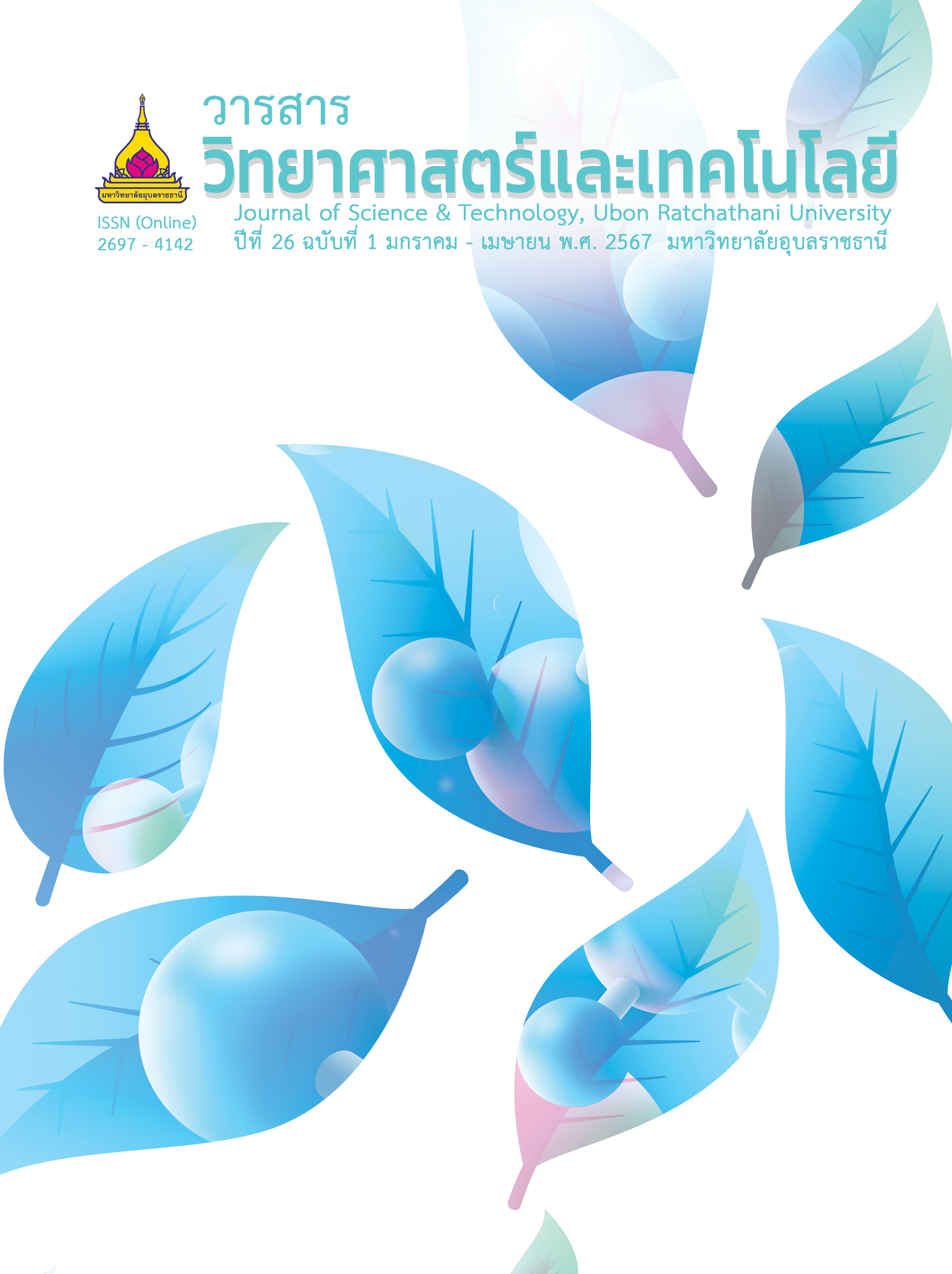การวิเคราะห์ปริมาณสารตกค้างคาร์เบนดาซิมและไทอะเบนดาโซลในผักจากตลาดสด อำเภอเมือง จังหวัดเพชรบูรณ์ ด้วยเทคนิคโครมาโทกราฟีของเหลวสมรรถนะสูง
Main Article Content
บทคัดย่อ
คาร์เบนดาซิม และไทอะเบนดาโซลเป็นสารกลุ่มเบนซิมิดาโซล นิยมใช้เป็นสารฆ่าเชื้อราในผัก และผลไม้ ทั้งก่อนหรือหลัง การเก็บเกี่ยว อย่างไรก็ตามการได้รับสารเหล่านี้เป็นเวลานานส่งผลอันตรายต่อสุขภาพของมนุษย์ และสัตว์ งานวิจัยนี้มีวัตถุประสงค์เพื่อตรวจวัดปริมาณคาร์เบนดาซิม และไทอะเบนดาโซลในตัวอย่างผัก ด้วยเทคนิคโครมาโทกราฟีของเหลวสมรรถนะสูง การสกัดตัวอย่างใช้วิธีแบบแคชเชอร์ และทำให้บริสุทธิ์ด้วยการสกัดวัฏภาคของแข็งแบบกระจาย โดยใช้สภาวะการแยกด้วยคอลัมน์ C18 เฟสเคลื่อนที่ คือ น้ำและเมทานอล (50 : 50 %v/v) แบบไอโซเครติก ใช้อัตราการไหล 1 มิลลิลิตรต่อนาที อุณหภูมิของคอลัมน์เท่ากับ 40 องศาเซลเซียส ปริมาตรฉีด 5 ไมโครลิตร และตรวจวัดด้วยเครื่องตรวจวัดแบบฟลูออเรสเซนต์ โดยตั้งความยาวคลื่นในการกระตุ้นเท่ากับ 285 นาโนเมตร และความยาวคลื่นในการคายแสงเท่ากับ 340 นาโนเมตร จากการทดสอบความใช้ได้ของวิธีเคราะห์ โดยใช้สารละลายมาตรฐาน คาร์เบนดาซิม และไทอะเบนดาโซล พบว่าวิธีการวิเคราะห์มีความจำเพาะเจาะจง มีกราฟมาตรฐานเป็นเส้นตรงที่ความเข้มข้นของสารเท่ากับ 0.050-3.00 มิลลิกรัมต่อกิโลกรัม ด้วยค่าสัมประสิทธิ์ของการตัดสินใจมากกว่า 0.995 มีขีดจำกัดในการตรวจวัดเชิงปริมาณที่ความเข้มข้นของสารเท่ากับ 0.065 และ 0.074 มิลลิกรัมต่อกิโลกรัมสำหรับคาร์เบนดาซิม และไทอะเบลดาโซล ตามลำดับ และมีความแม่น และความเที่ยงในเกณฑ์ที่ยอมรับได้ จากการนำตัวอย่างผักจากตลาดสด อำเภอเมือง จังหวัดเพชรบูรณ์จำนวน 50 ตัวอย่าง มาวิเคราะห์ปริมาณคาร์เบนดาซิม และไทอะเบนดาโซลตามวิธีที่ผ่านการทดสอบความใช้ได้แล้ว พบว่าไม่พบไทอะเบลดาโซลในตัวอย่างทั้งหมด แต่พบคาร์เบนดาซิมตรวจพบในตัวอย่างต้นหอม ในปริมาณที่ไม่เกินค่าปริมาณสารพิษตกค้างสูงสุด (MRL) ที่กำหนดโดยกระทรวงสาธารณสุข และพบสารดังกล่าวในผักสลัด และคะน้าในปริมาณที่เกินค่า MRL ซึ่งเป็นอันตรายต่อผู้บริโภค
Article Details

อนุญาตภายใต้เงื่อนไข Creative Commons Attribution-NonCommercial-NoDerivatives 4.0 International License.
บทความที่ได้รับการตีพิมพ์เป็นลิขสิทธิ์ของ วารสารวิทยาศาสตร์และเทคโนโลยี มหาวิทยาลัยอุบลราชธานี
ข้อความที่ปรากฏในบทความแต่ละเรื่องในวารสารวิชาการเล่มนี้เป็นความคิดเห็นส่วนตัวของผู้เขียนแต่ละท่านไม่เกี่ยวข้องกับมหาวิทยาลัยอุบลราชธานี และคณาจารย์ท่านอื่นๆในมหาวิทยาลัยฯ แต่อย่างใด ความรับผิดชอบองค์ประกอบทั้งหมดของบทความแต่ละเรื่องเป็นของผู้เขียนแต่ละท่าน หากมีความผิดพลาดใดๆ ผู้เขียนแต่ละท่านจะรับผิดชอบบทความของตนเองแต่ผู้เดียว
เอกสารอ้างอิง
Nuchnuanrat, P. and Jitsatta, N. 2021. Evaluation of fungicide carbendazim resistance in Colletotrichum gloeosporioides causing anthracnose disease of mango cv. Aokrong in Chanthaburi province. RMUTSB Academic Journal. 9(2): 164-173. (in Thai)
Yu, Q.W. and et al. 2017. Monitoring of carbendazim and thiabendazole in fruits and vegetables by SiO2@NiO-based solid-phase extraction coupled to high-performance liquid chromatography-fluorescence detector. Food Analytical Methods. 10(8): 2892-2901.
Zheng, D. and et al. 2022. Flowerlike Ni-NiO composite as magnetic solid-phase extraction sorbent for analysis of carbendazim and thiabendazole in edible vegetable oils by liquid chromatography-mass spectrometry. Food Chemistry. 374: 131761.
Rouabhi, R. 2010. Introduction and Toxicology of Fungicides. London: IntechOpen Limited.
Fares, N.V. and et al. 2021. Determination of fungicides' residues and their degradation kinetics in orange tree fruits using liquid chromatography-tandem mass spectrometry coupled with QuEChERS method. Microchemical Journal. 168: 106376.
Codex Alimentarius. 2022. Pesticides. https://www.
fao.org/fao-who-codexalimentarius/codex-texts/ dbs/pestres/pesticides/en/. Accessed 1 May 2023.
National Bureau of Agricultural Commodity and Food Standards, Ministry of Agriculture and Cooperatives. 2016. Thai Agricultural Standard (TAS 9002-2016) Pesticide Residues: Maximum Residue Limits. https://www.acfs.go.th/standard/ download/MAXIMUM-RESIDUE-LIMITS.pdf. Accessed 5 March 2023. (in Thai)
Xu, X. and et al. 2018. Carbendazim residues in vegetables in China between 2014 and 2016 and a chronic carbendazim exposure risk assessment. Food Control. 91: 20-25.
Phansawan, B. and et al. 2015. A sensitive method for determination of carbendazim residue in vegetable samples using HPLC-UV and its application in health risk assessment. Chiang Mai Journal of Science. 42 (3): 681-690.
Chen, Y. and et al. 2022. Quantitative analysis of carbaryl and thiabendazole in complex matrices using excitation-emission fluorescence matrices with second-order calibration methods. Spectrochimica Acta Part A: Molecular and Biomolecular Spectroscopy. 264: 120267.
Hazer, O. and et al. 2017. Determination of carbendazim and chlorpyrifos in selected fruits and vegetables samples using QuEChERS-HPLC-FD. Eurasian Journal of Analytical Chemistry. 12(2): 17-30.
Ahn, S. and et al. 2021. Accurate determination of carbaryl, carbofuran and carbendazim in vegetables by isotope dilution liquid chromatography/tandem mass spectrometry. Chromatographia. 84: 27-35.
Pallavi, M.S. and et al. 2021. Simultaneous determination, dissipation and decontamination of fungicides applied on cabbage using LC-MS/MS. Food Chemistry. 355: 129523.
Krinsunthon, N., Khamthong, T. and Mapradit, P. 2021. Sample preparation for determination of steroids adulterated in herbal pills by high performance liquid chromatography. Thai Food and Drug Journal. 21(1): 59-66. (in Thai)
Chaimongkol, T. and Wittayanan, W. 2018. Development of sample preparation for pesticide residues analysis in difficult food matrices. Burapha Sciecne Journal. 23(3): 1462-1437. (in Thai)
Varela-Martinez, D.A. and et al. 2020. Quick, easy, cheap, effective, rugged, and safe (QuEChERS) extraction. In: Poole, C.F. (ed.) Liquid-Phase Extraction. Amsterdam: Elsevier.
Fares, N.V. and et al. 2021. Determination of fungicides' residues and their degradation kinetics in orange tree fruits using liquid chromatography-tandem mass spectrometry coupled with QuEChERS method. Microchemical Journal. 168: 106376.
Ningnoi, T. 2006. A Practical Guide for Single Laboratory. Method Validation of Chemical Methods. Nonthaburi: Department of Medical Sciences, Ministry of Public Health. (in Thai)
Chandran, S. and Singh, R.S.P. 2007. Comparison of various international guidelines for analytical method validation. Die Pharmazie. 62(1): 4-14.
Eurachem. 2014. The Fitness for Purpose of Analytical Methods: A Laboratory Guide to Method Validation and Related Topics. 2nd edition. https://www.eurachem.org/images /stories/ Guides/pdf/MV_guide_2nd_ed_EN.pdf. Accessed 18 June 2022.
Jitkaew, N. and Sinaviwat, S. 2022. Method validation for determination of sucralose in beverage by high performance liquid chromatography. Bulletin of Applied Sciences. 11(11): 35-44. (in Thai)
Zhang, Y. 2019. Analysis of Organophosphorus and Organochlorine Pesticides in Fruit and Vegetables Using an Agilent 8890 GC with Four Detectors. https://www.agilent.com/cs/ library/applications/application-organophosphorus -organochlorine-pesticides-5994-1215en-agilent.pdf. Accessed 8 November 2022.
Bose, A. 2014. HPLC calibration process parameters in terms of system suitability test. Austin Chromatography. 1(2), 1-4.
Qin, G. and et al. 2021. Risk assessment of fungicide peticide residues in vegetables and fruits in the mid-western region of China. Journal of Food Composition and Analysis. 95: 103663.
Ngamsakpasert, C. and et al. 2021. Reduction of carbendazim in Chinese chives and re-absorption from washing solution using methods of Department of Agriculture. Thai Journal of Science and Technology. 24(4): 629-640. (in Thai)


